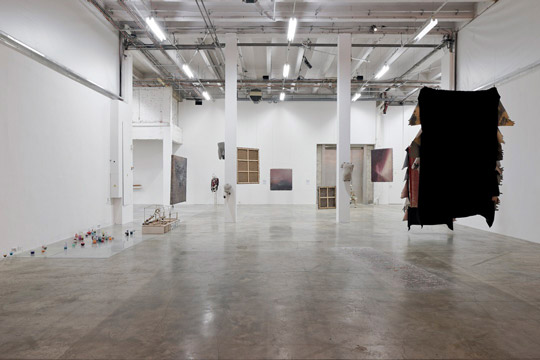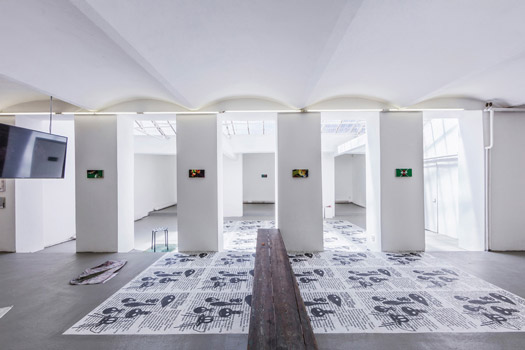Solitude and collectivity, slowness and speed: Jo-ey Tang in conversation with Federico Nicolao
To mark ECAL’s 10th anniversary at its current site renovated by architect Bernard Tschumi for the influential art and design school in Lausanne, Switzerland, Jo-ey Tang, Beeler Gallery’s new Director of Exhibitions, shares his curatorial philosophy with ECAL (Ecole cantonale d'art de Lausanne) lecturer Federico Nicolao in the new book Making Sense: 10 Years of Research in Art and Design at ECAL. This conversation on artistic research, “Solitude and Collectivity, Slowness and Speed,” is reprinted in its entirety here.

© ECAL/Calypso Mahieu

Jo-ey Tang, born in Hong Kong, is an American artist, curator and art writer. He studied at the San Francisco Art Institute and earned his master’s degree from New York University before completing post-graduate work at the Université Paris 1 Panthéon-Sorbonne. He founded the curatorial project The Notary Public, where he staged its first exhibitions in his New York apartment. He also served as a curator at Palais de Tokyo (2014– 2015), where he conducted more than 200 studio visits of emerging artists in China, Hong Kong, Taiwan, Myanmar, Singapore, France and Germany. He was an arts editor (2009– 2014) at n+1, a literary magazine, and is a frequent contributor to Artforum. He participated in a research residency at Villa Arson, Nice (2016 – 2017), and was recently appointed Director of Exhibitions of Beeler Gallery at Columbus College of Art & Design, Columbus, USA.
Jo-ey Tang curated More Than Lovers, More Than Friends, at the FUTURA Centre for Contemporary Art, Prague (2016), which included Kasper Bosmans, Sonja Engelhardt, Marthe Ramm Fortun, Jason Hendrik Hansma, Barbora Kleinhamplová, Li Jinghu, Tan Lin, K.r.m. Mooney, Pierre Paulin, Parallel Practice, Carlos Reyes, Ben Schumacher, Augustas Serapinas, and Allison Somers. As a visual artist, Tang has exhibited at the Institut d’art contemporain (IAC), Villeurbanne; Lyles & King, New York; Galerie Joseph Tang, Paris; and Galerie Nathalie Obadia, Paris.
Federico Nicolao: In your view, which communities can artists belong to nowadays without feeling ashamed?
Jo-ey Tang: A roundabout way to answer this question. I try to give to each encounter. The older I get, the more trust I have in my own subjectivity, informed not by art alone but also by experiences in the world. That hopefully makes relating easier, or at least less stressful! I am more interested in what makes someone do what they do, their thinking and creative processes. That is a good place to start for me. Communities form around one when one is aware, open, ethical, and I would say this is true for all people, including artists.
FN: How important it is for you to devote time and resources to visit artists’ studios and how does this help you design exhibitions?
JT: I think the goal of studio visits is not to turn what is there into an exhibition. It is always necessary to wrest oneself away from the urgency of decisions and resist the fantasy of putting artworks into the context of an exhibition. Exhibitions are not the end goals. Perhaps this is counter-intuitive or naive, but I believe that an exchange can turn into a lifetime of learning together. Of course, I have no proof of that, yet, since life is ongoing. Though my eyes often stray to what’s tucked behind, or something casually laid out on the side. This might be planned by the artist. There is a bit of a game involved. On the other hand, this stage towards discovery charges the artwork as it is allowed to enter life.
FN: How important is friendship with artists for you? Who are your closest artist friends, and how much have they influenced your choices?
JT: To live alongside artists and people is an act of sustenance. I have a handful of true friends whose lives are testaments to possibilities, to alternatives.
FN: To which memory or biographical object do you feel close enough to turn it into an exhibition?
JT: I like to go around the object or catch the moment of something in the making. Sometimes the obvious thing, the closest thing, is the most obscure — like a blind spot. For example, 19th-century photographer Nadar’s image of the expanding interior of his hot-air balloon, Le Géant, that he used to carry himself to take some of the first aerial photographs, was a perceptual device for Inside China – L’Intérieur du Géant (2014), at the Palais de Tokyo, Paris. Or, a simple qualifying phrase, More Than Lovers, More Than Friends (2015), which was the title of an exhibition at the FUTURA Centre for Contemporary Art, Prague, that disequates with what we might have already accepted in the possibility of relations.

Installation view, Inside China – L’Intérieur du Géant, Palais de Tokyo, 2014. Courtesy of Jo-ey Tang and Palais de Tokyo.
FN: What disrupted mindset should you hold onto when building an exhibition? What role have moods played in the way you conceive exhibitions? Love? Melancholy? Anger? Can these be a trigger and even give an exhibition a particular direction? Or should they be kept under control?
JT: There is always something fuzzy, yet direct, in the way I like to construct an exhibition, with full knowledge that what I am thinking has the possibility of being nullified as the direct opposite. It is like a nervous person who appears confident speaking in front of a crowd. What one thinks and how one appears are diametrical. It is not that expectations are to be disposed of, but that they could be used as a sail in the wind, to court the unknown.
FN: Slowness and speed are two diametrically opposed components that very often end up determining the nature of an exhibition. The decision-making for the design of an exhibition nowadays all happens very quickly, yet this often very fast pace can also lead to the culmination of ideas that take shape very slowly. How do you deal with both slowness and speed in your exhibitions?
JT: Density is a way to think about and move through slowness and speed. Each exhibition has a sonic equivalence. Tut-tut-chut-chut-pfffffftu-lut-tulut-chhhhuuuu-tut-tut-chuuuu. Speed could, however, be deceptive. Think of how a slow glance and a quick stare can occur in time. You know when we say, ’I cannot believe it’s been [insert duration of time]’ or ’I cannot believe it’s only been [insert duration of time] here’? That’s the least an exhibition can hope to do.
FN: Despite a contemporary fashion that requires young artists, from the time they leave school, to know how to be able to present and talk about their work, language is in obvious crisis as it is largely unable to identify or to name the art of our time. You have used short-text and chronicle formats. Do you think that there is, or can be, a language that can cut through the noise around works and their perception or, at least, temper its vanity?
JT: Maybe going right for it can give it right back.
FN: How do your exhibitions rethink the notion of the collective? How do you decide between singularity and solitude, on the one hand, and articulation of or within a group of ideas that emerge in an exhibition?
JT: The acknowledgment of kinships and the acceptance of my subjectivity that arises out of encounters with art objects, people, and ideas have been important to negotiate the self in a constellation that consists of those objects, people, and ideas. Exhibitions articulate something quite different, though. Which collective, and which selves? I like to think about the instance when a group of friends gets together to see an exhibition. The manner in which the group sticks together, or they stray away from each other, seems telling, complex, and is neither about an exhibition nor completely disavows it. I think we are just beginning to understand what going ’through’ an exhibition means. It is not over yet.

Installation view, More Than Lovers, More Than Friends, FUTURA Centre for Contemporary Art, Prague, 2016. Courtesy of Jo-ey Tang and FUTURA, Prague
From Solitude and Collectivity, Slowness and Speed: Jo-ey Tang in conversation with Federico Nicolao, in Making Sense. 10 Years of Research in Art and Design at ECAL, edited by Davide Fornari, ECAL, Renens 2017, pp. 206 – 209.
For more information and to purchase the book Making Sense: 10 Years of Research in Art and Design at ECAL, please visit researchday.ch/#book.